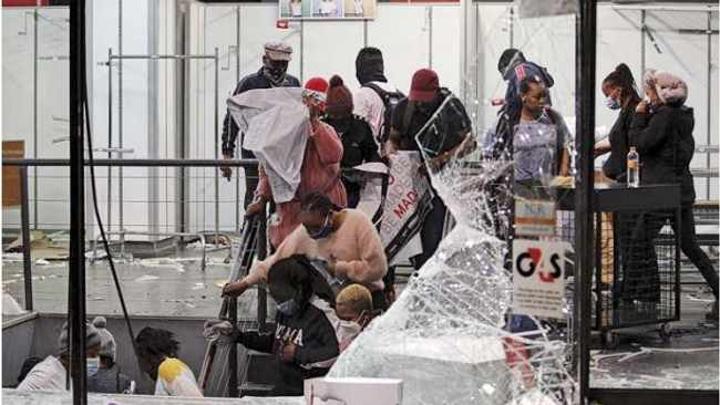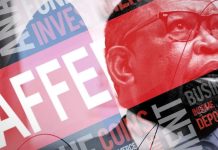Africa-Press – South-Africa. By Annah Moyo-Kupeta
The latest violence in South Africa, after the arrest of former president Jacob Zuma and the mayhem that followed, of looting, killings, destruction of property, arrests of many citizens and overall insecurity, is a testament to how “justice” in the eyes of an angry mob takes a deadly and destructive turn.
For a country ranked as the third most dangerous in the world, according to Numbeo’s 2021 crime index, vigilantism – where angry citizens driven by their own emotions of anger and frustration, with some in the crowd having different agendas – determine what is just, and mete out “justice” in their own terms, is a great cause of concern.
The 2019 report from the Institute for Security Studies highlights the stark reality that at least two people die as a result of vigilante attacks in South Africa a day. The death of more than 200 people from the latest violence in South Africa is alarming.
The mob psychology behind the emboldening of otherwise law-abiding citizens, and the ease with which violence escalates, quickly spreading like wildfire to the rest of the country, destroying everything in its wake, is a great concern.
This begs answers to these questions: What is it about group or mob mentality that makes even the best of us do the unthinkable? What is it about crowds that makes individuals lose their sense of self, reasoning and rationality, making them do things they would never do as individuals? Why is it that a cause, whether genuine or misplaced, often gets hijacked, morphing into brazen criminality, with the original cause getting lost in the mayhem and criminality standing prominent in the end?
With the recent events, following on the heels of the Zandspruit mob killings in May this year, we, as a society, as communities, families and individuals, cannot afford to ignore the questions.
An attempt to answer them must be contextualised within the violence landscape in the post-1994 South Africa.
Violence in South Africa does not occur in a vacuum. Mob justice, a form of collective violence, is usually a culmination of anger and frustration accumulated over time over structural inequality, the legitimate yet deferred expectations of what democracy ought to have delivered to the majority of black people who continue to live in abject poverty.
To this mix, add corruption and pillaging of state-owned enterprises, poor service delivery and the overall unresolved trauma of South Africa’s brutal and violent past. These on their own constitute a powder keg that can be triggered at any time, by any cause.
With the additional stressors of the Covid-19 pandemic, the unprecedented increase in unemployment, the failure by the government to extend the social relief grants beyond April this year and the level 4 lockdown regulations that have rendered many jobless and with small companies on the brink of closure, the socio-economic challenges have compounded.
Zuma’s arrest was a trigger that presented an unwitting opportunity for collective galvanising, an outlet for simmering frustrations and desperation sparked by multilayered issues that threaten livelihoods. Any issue, whether political, socio-economic, injustice or corruption-related, would have been enough to mobilise the crowds and ignite the kind of collective violence experienced.
To answer the questions posed earlier, we must understand mob or crowd mentality and its impacts on individuals. Crowds come with safety in numbers. There is deindividuation in crowds – they are a space where people can easily engage in seemingly impulsive, deviant and violent acts, in the belief that they cannot be individually identified.
In crowds, group actions and group decisions take priority over individual, self-evaluated and reasoned actions. There is decreased inhibition and most people, even the best among us, can easily lose self-consciousness. This is heightened by feelings that wrong or criminal behaviour cannot be singled out. There is a diminished sense of right and wrong and carrying the blame. There is rather a heightened need to act together, to become part of the crowd and belong to the crowd.
There is no room for taking the moral ground or be the voice of reason, and whether out of fear or a sense of not wanting to be the odd one out, the collective voice governs, the first stone ignites 50 others and the first stroke that breaks a window signals the same behaviour from everyone else. This explains why mob mentality encourages irrationality and why things easily escalate to extreme violence. It explains how members in a mob setting follow one another and carry out the same acts, as if on a cue.
A a response to the last question, it must be pointed out that while mob justice often starts with a cause, one that is genuine for the majority of those protesting, the agenda often gets hijacked by criminal elements with a different agenda and who see an opportunity to escalate things.
When criminal elements become ring leaders, the message and the cause get lost quickly as they deviate from their agenda, taking advantage of the very issues angering and frustrating community members. They instigate violence and ungovernability of the responses from the crowd. With the frustration and anger, it becomes an easy task to sway the crowd to a more violent and extreme response.
Many community members do not leave their homes or set off to join the protests or the crowds set on violence and murder. Many are simply mobilised around the need for social change. Many do not leave their homes with criminal intent, in fact, more often than not, criminality mindset and behaviour spread at the site of the crime, at the instigation of criminal opportunists in the crowd.
The violent protests and the looting that followed highlighted that opportunism and criminality during protests and the mayhem that follows is also in categories. There are those whose criminality is at the forefront, hijacking the cause as ring leaders and instigators of criminality.
In the latest violent protests, this group of criminals have cast the proverbial “first stone” and have set the country alight with violence and killings. Then there are criminals who have seen the shop doors open, and in their convoluted and multilayered desperation for food and things that have been out of reach yet desired, have since joined the looting bandwagon and their reasons are merely survival and feeding their families. They are all criminals under our penal code, yet for different reasons altogether.
As we have seen with the arrests of more than 1 700 individuals during the violence and mayhem, there are implications to mob killings. As is the case with all criminality and criminal behaviour, mob violence, mob justice and mob killings attract criminal sanctions for those participating and implicated.
Unfortunately, in a crowd setting, guilt by participation often applies. This is because, in most instances, it is difficult to point out who threw the stone that broke the window, which stone did the utmost damage or whose bullet landed in the victim’s body.
In the mayhem, all this is unclear. For innocent members of the community who genuinely started off with a cause and were never intent on committing a crime, they became criminals overnight.
While protesting is a right, violence and mayhem, including the killings that follow, are criminal offences. The law ultimately takes its course. The implications also drastically alter the lives of the families of the victims and community members at large.
The right to life of the people killed during this time has been taken away, and trauma for the families of the deceased and those who witnessed the killings is almost indelible. The right to life has been violated and this right is non-derogable, meaning that it cannot be taken away from anyone, and remains intact even in a state of emergency.
Community members who partake in mob justice killings are, therefore, in violation of this right. Some of the lives cut short so suddenly, are victims of having been in the wrong place at the wrong time.
With mob justice, violent protests and collective violence cases, two things are certain. First, it is evident violence in South Africa, as endemic as it is, is sparked and triggered by many other issues that when not addressed, will lead to a sharp increase of such violent protests and loss of many lives.
Second, it is clear that we cannot address the scourge of violent protests through the criminal justice alone as this is akin to bandaging the wound while it continues to fester inside. We need to address the root causes, the very issues that have made it so easy for any event to become a mobilising and crowd-galvanising issue.
* Annah Moyo-Kupeta is a human rights lawyer and acting executive director at the Centre for the Study of Violence and Reconciliation.
**The views expressed in this article are not necessarily CSVR’s position.
*** The views expressed here are not necessarily those of Independent Media.






